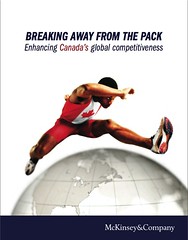A new take on ramping up Canadian competitiveness
November 13, 2008

According to a recent study from the big brains at McKinsey & Company, the competitiveness of Canada’s economy has tumbled over the last 25 years. First up, the bad news:
- Since 1990, our national competitiveness has dropped from 5th in the world to 10th (according to the OECD’s per capita analysis).
- Our share of global FDI (foreign direct investment) slid from an impressive 10% in 1980 to a woeful 3% in 2006.
- Key export sectors like manufacturing have underperformed their global peers – and further affected our overall productivity.
- China has replaced Canada as the largest trading partner of the United States.
Thankfully — as MaRS gets to see every day — the country also possesses considerable strengths.
According to McKinsey’s analysis, Canada possesses a competitive advantage in both human resources and natural resources (one of only three countries in the world thus blessed — along with Norway and Australia). We control the world’s second largest oil reserves, the third largest forestry reserves and enormous quantities of water and mineral rights. The OECD ranks the Canadian educational system as the world’s fifth-best. We’re also fourth on the UN’s Human Development Index (though we ranked #1 from 1994-2000).
However, the report offers far more than pages of analysis. It’s also deliberately and explicitly prescriptive – laying out a series of focused, compelling steps that government, industry and innovation stakeholders should take to enhance Canada’s economic competitiveness. The recommendations are clustered around the themes of (1) capital (2) collaboration and (3) culture – language very close to our heart (and perhaps this shouldn’t surprise, since the report includes an expanded shout-out to MaRs on p.33). Here’s a few that struck especially close to home:
- On capital: First, reduce or eliminate the kinds of policies that discourage foreign investment (like withholding taxes and foreign ownership restrictions. Second, get out into the world and market Canada as a top-tier investment location. Third, develop a world-class VC community.
- On collaboration: First, develop new and improved public-private collaboration and co-investment models. Second, select a handful of top-tier cluster opportunities and back them aggressively. Third, develop global partnerships across key industry value chains.
- On culture: First, attract the best graduates to teaching. Second, develop new IP ownership models that help researchers and institutions commercialize their discoveries here at home. Third, help emerging business (ed. – and government) leaders learn across sectors, industries and borders.
A lot to digest here — and I’ve only listed a smattering of the ideas articulated in this crisply-written 48-page report (plus appendices). With the Canadian and global economies experiencing significant turbulence, the report makes for timely reading, and it deserves the widest possible audience.